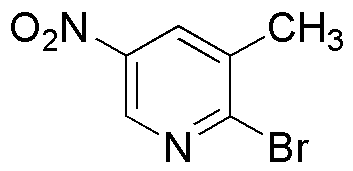2-Bromo-3-methyl-5-nitropyridine is widely utilized in research focused on:
- Synthetic Chemistry: This compound serves as a key intermediate in the synthesis of various pharmaceuticals and agrochemicals, enabling the development of new drugs and crop protection agents.
- Pharmaceutical Development: It is used in the creation of biologically active molecules, particularly in the development of anti-cancer and anti-inflammatory drugs, providing researchers with a versatile building block.
- Material Science: The compound finds applications in the production of advanced materials, including polymers and coatings, which benefit from its unique chemical properties.
- Analytical Chemistry: It is employed as a reagent in analytical methods, aiding in the detection and quantification of various substances, thus enhancing the accuracy of chemical analyses.
- Biological Research: Researchers utilize it to study biological pathways and mechanisms, particularly in the field of medicinal chemistry, helping to identify potential therapeutic targets.
General Information
Properties
Safety and Regulations
Applications
2-Bromo-3-methyl-5-nitropyridine is widely utilized in research focused on:
- Synthetic Chemistry: This compound serves as a key intermediate in the synthesis of various pharmaceuticals and agrochemicals, enabling the development of new drugs and crop protection agents.
- Pharmaceutical Development: It is used in the creation of biologically active molecules, particularly in the development of anti-cancer and anti-inflammatory drugs, providing researchers with a versatile building block.
- Material Science: The compound finds applications in the production of advanced materials, including polymers and coatings, which benefit from its unique chemical properties.
- Analytical Chemistry: It is employed as a reagent in analytical methods, aiding in the detection and quantification of various substances, thus enhancing the accuracy of chemical analyses.
- Biological Research: Researchers utilize it to study biological pathways and mechanisms, particularly in the field of medicinal chemistry, helping to identify potential therapeutic targets.
Documents
Safety Data Sheets (SDS)
The SDS provides comprehensive safety information on handling, storage, and disposal of the product.
Product Specification (PS)
The PS provides a comprehensive breakdown of the product’s properties, including chemical composition, physical state, purity, and storage requirements. It also details acceptable quality ranges and the product's intended applications.
Certificates of Analysis (COA)
Search for Certificates of Analysis (COA) by entering the products Lot Number. Lot and Batch Numbers can be found on a product’s label following the words ‘Lot’ or ‘Batch’.
*Catalog Number
*Lot Number
Certificates Of Origin (COO)
This COO confirms the country where the product was manufactured, and also details the materials and components used in it and whether it is derived from natural, synthetic, or other specific sources. This certificate may be required for customs, trade, and regulatory compliance.
*Catalog Number
*Lot Number
Safety Data Sheets (SDS)
The SDS provides comprehensive safety information on handling, storage, and disposal of the product.
DownloadProduct Specification (PS)
The PS provides a comprehensive breakdown of the product’s properties, including chemical composition, physical state, purity, and storage requirements. It also details acceptable quality ranges and the product's intended applications.
DownloadCertificates of Analysis (COA)
Search for Certificates of Analysis (COA) by entering the products Lot Number. Lot and Batch Numbers can be found on a product’s label following the words ‘Lot’ or ‘Batch’.
*Catalog Number
*Lot Number
Certificates Of Origin (COO)
This COO confirms the country where the product was manufactured, and also details the materials and components used in it and whether it is derived from natural, synthetic, or other specific sources. This certificate may be required for customs, trade, and regulatory compliance.
*Catalog Number
*Lot Number
Citations
Sign up and save
Entice customers to sign up for your mailing list with discounts or exclusive offers.


